SAVE THE PREHISTORIC WHALES!

The Bangudae Petroglyphs in Daegok-ri, Ulsan, South Korea. A tracing of the complete rock art panel by Dr. Sang-mog LEE with his kind permission.
There is an increasing possibility that the Bangudae Petroglyphs, which were the subject of the following call-to-arms in 2007, may be saved - not by draining the reservoir as I suggested here, since that might have revealed other panels, but by building a semi-circular dam around the rock face, as shown below in an artist’s rendering from The Korea Herald (“Solution Still Out of Sight?” 20 Jan. 2014). But the fact is their fate is still far from clear, since the proposal has hit a major regulatory hurdle.
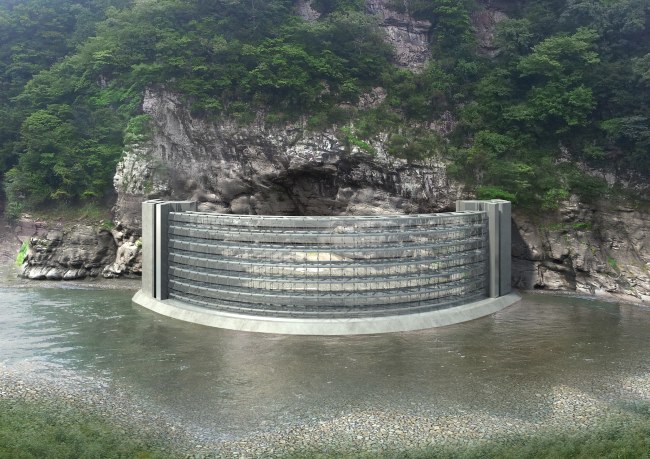
*
TIME IS RUNNING OUT FOR THE GREATEST WORK OF PREHISTORIC ART IN NORTHEAST ASIA.
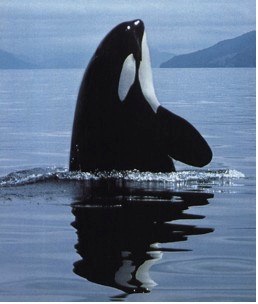
This created a conservationist’s nightmare because the raised water placed the petroglyphs right in the flood zone, where they’re scoured by sediments and flotsam and cyclically destabilized by soaking and drying. After surviving 7,000 years, they may be abraded away within a century or two, at most.
Yet no one’s really to blame - at least for the initial flooding. Not a single prehistoric petroglyph had been reported in Korea back then, so the salvage archaeologists who surveyed the valley never dreamed of looking at the rock faces. Instead of looking for scapegoats, the question is simply, what should be done now?
The most conservative solution is to build a coffer around the outcropping so it can be visited while its condition is re-stabilized. The dike could house a viewing platform or even a roofed museum. A more radical solution would be to condemn the dam, drain the reservoir, prospect for other engravings, which local old-timers say were drowned deeper in the valley, and turn the zone into an archaeological park that would draw tourists to Ulsan while providing Hyundai with the chance to become the far-sung patron of a world heritage site!
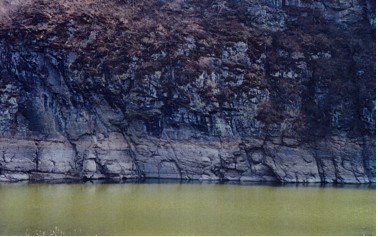
The petroglyphs are just below the surface at the center of the photo.
But, incredibly, the company squandered the perfect opportunity to find out what the valley really contained and even save the art panel when the firm realized, a few years ago, that it no longer needed the reservoir’s water. Instead of seizing the opportunity to empty the valley and turn it into a park under its patronage, which could have earned it enormous goodwill worldwide, Hyundai actually decided to exacerbate the problem by make the barrage 2 meters higher so the reservoir could hold enough drinking water to tempt the city into taking the white elephant of a dam off the company’s hands. A cast of the panel was made for the Gyeongju National Museum but the actual petroglyphs were left to their fate.
So the question of what to do is getting embarrassingly old - something recognized by at least one inspired official: Che-Ik Lee, the Chief of the Namgu Ward of Ulsan Metropolitan City, who has written a highly informative call to arms that vividly describes how the reservoir has visibly eroded the petroglyphs from one season to the next - chipping it with dryings and soakings before his eyes! Officials like Mr. Lee need all the support they can get to help persuade Korea’s decision-making bodies to make the effort to find out what else has been drowned while taking urgent steps to protect the known panel. What will it take to convince his more reticent peers - another international campaign like the one to save Foz Coa’s petroglyphs?
The need for protective measures is so obvious and relatively cheap, with a coffer costing about the same as a subterranean parking garage, that you wouldn’t think that local and national governments would need either reminders or a nudge. So I implore them to answer Mr. Lee’s plea and take the initiative to find out if the valley of the whales contains more wonders while saving the greatest rock art in northeast Asia!
*
Taking this a step further, it seems odd that no one has ever reported such art from Japan even though the Korean frieze is at the closest point to the archipelago and proves that the peninsula’s seafaring whale hunters could have easily crossed the strait! Could it be that the Japanese haven’t been looking hard enough because they’ve never associated their country with rock art - as was the case in Korea until so recently? Wouldn’t it be wonderful if someone were to find similar art on the other side of the strait - giving the two countries a piece of shared heritage that could help put their recent enmities into perspective?
If anyone hears of more prehistoric rock art of this stature in Korea, Japan or anywhere else in northeast Asia, I’d love to include it in a documentary that I’m preparing about the Bangudae Petroglyphs and rock art around the northern Pacific rim.
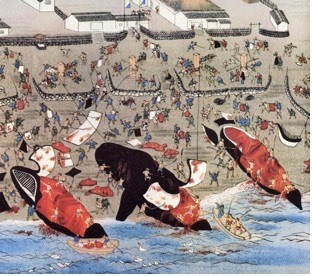
The Valley of the Whales
The panel of animal and human imagery begins with a rhinoceros that almost certainly dates it to the Upper Paleolithic of at least 13,000 years ago, when such animals disappeared from the peninsula, and ends with whales so detailed that we see their spouts, belly wrinkles, and the boats, floats and harpoons used to hunt them. Whale and seal bones and harpoons from a nearby shell midden suggest that the people who lived there from 7,000 to 3,500 years ago created the panel’s spectacular depiction of sea mammals.

A section of the rock art panel photographed by Dr. Sang-mog LEE. With his kind permission.
So it’s all here – the best imagery from the Paleolithic to the Neolithic - in an epic frieze that may be arranged to show a seasonal cycle of activities and renewal. One has to go no farther than the first detail on the left – a pod of 3 spouting whales seen in profile – to be overwhelmed by the detail of this narrative window into the past - details like a baby whale protected between the first two whales and a man who appears to be standing in a boat attached to skin buoys linked by harpoon lines to the second and third whales.
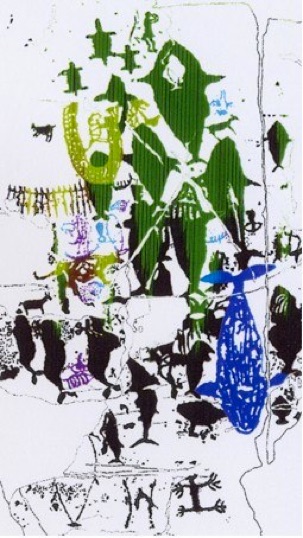
Could this procession led by a Pied Piper of Whales and followed by a crushed anthropomorph turning into a sea creature be the retelling of a mythical hunt? Or an image of shamanistic transformation and meetings with animal agents or spirits? Was the biggest whale of them all – an ancient Moby Dick – killed, only to drag its killer into the deep? Did these people like so many modern groups around the northern Pacific rim, believe in a submarine afterlife? All that’s obvious is that the narrative is as moving as a resounding opera in a language we will never quite understand.
Yet that’s just the opening scene from a panel 6 times larger. In short, East Asia and all of humanity is in the process of losing the earliest epic from that part of the world.
Or we could be on the brink of finding a cornucopia of unknown art if the reservoir is emptied ….
SOLUTIONS
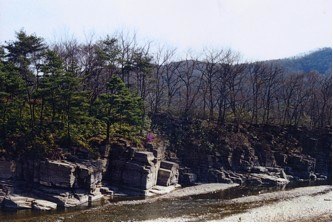
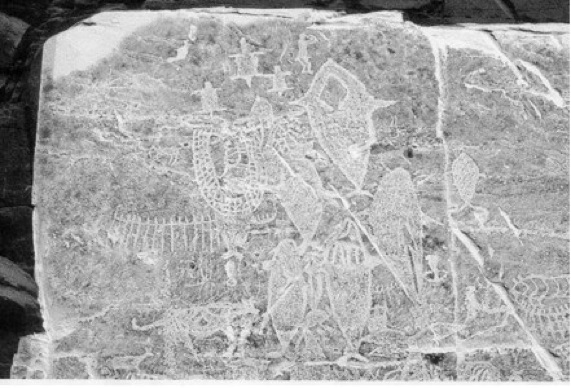
Another section of the rock art panel photographed by Dr. Sang-mog LEE. With his kind permission.
The possible discovery of more art would pose further, but hardly insurmountable, challenges. After all, the reservoir is fairly small and redundant – never having been used for drinking water before – and the upper part of the valley, without art, could still be dammed.
Also, it is essential to note how magnetic prehistoric art can be in terms of tourism - the Ardeche Gorge, for example, now attracts 2.5 million tourists each summer with its promise of canoeing, hiking and a peek into humanity’s past. The Coa Valley Archaeological Park receives more tourists during certain months than the guides can handle. On a sheer macro-economic level, it would obviously be disastrous for France, Portugal – or Korea, for that matter – to submerge their most enthralling prehistoric legacies.
And, again, the Hyundai Corporation would be perfectly positioned to take the lead in saving and celebrating such marvels which would extend Korea’s sense of its own cultural greatness while enhancing the company’s and country’s reputation around the world.
Foreign museums, universities and related institutions can help in this endeavor by helping to celebrate this masterpiece while participating in calls to preserve it. I have resuscitated Prehistoric Art Emergency to centralize appeals and will gladly provide guidance.
HOW RARE, REALLY, IS THE ANCIENT ART PANEL?
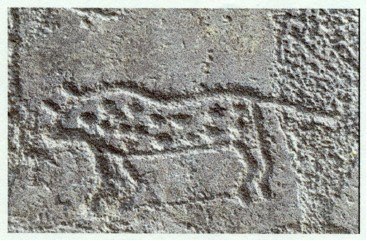
When the team returned to the site the next spring to study the art in depth, they met another villager who told them there were more engravings nearby – only they were submerged for the moment behind a dam. So the team returned to the area yet again - on Christmas 1971. This time their timing was perfect, the water level had fallen during the dry season and the panel stood exposed.
Except for this lucky streak, Korea’s greatest prehistoric masterpiece would have been lost – perhaps forever.
Although the panel obviously consists of several super-imposed levels of art, starting with large carnivores whose markings are clearly indicated and ending with marine mammals whose contours are usually completely pecked out, it is also evident that the panel is a whole. Out of all of Korea, this one spot seems to have been chosen by prehistoric populations over thousands of years as they renewed its sacredness with imagery that they felt would complement older visions.
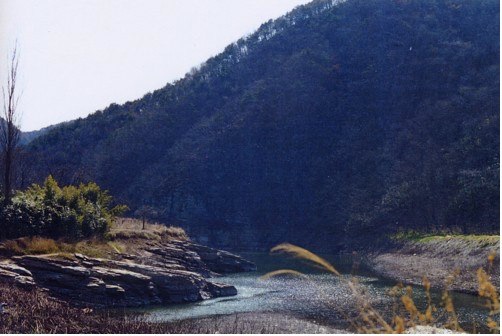
Our efforts, ranging from documentaries to exhibitions, to encourage and complement Korean projects to save the art will analyze the panel’s myriad clues and “sub-texts” to reveal a surprising link to one of the greatest achievements of all time – the spread of whale-hunting cultures across the Northern Pacific to the Americas! Hopefully our joint efforts will be enough to win this concentrated vision of East Asian prehistory the esteem it deserves – and desperately needs - before it’s too late.
For more information please contact:
paleothought(at)yahoo.com
Tel. +33-14804-0356 (Nov. thru June)
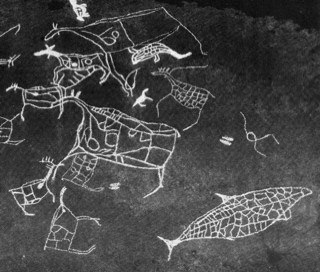
From the other side of the world, a Scandinavian petroglyph also shows whales
© 2007 Text, Duncan Caldwell; all photos courtesy Dr. Sang-mog Lee










